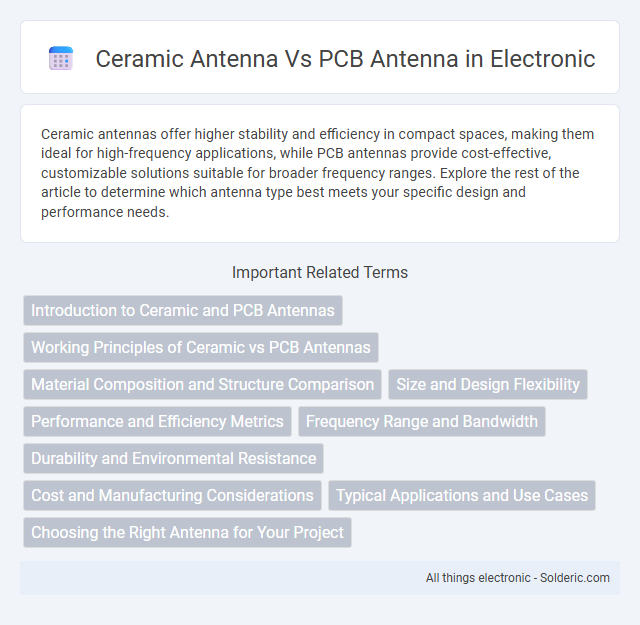Ceramic antennas offer higher stability and efficiency in compact spaces, making them ideal for high-frequency applications, while PCB antennas provide cost-effective, customizable solutions suitable for broader frequency ranges. Explore the rest of the article to determine which antenna type best meets your specific design and performance needs.
Comparison Table
| Feature | Ceramic Antenna | PCB Antenna |
|---|---|---|
| Material | High dielectric ceramic | Printed copper on PCB substrate |
| Size | Compact, small footprint | Varies, often larger than ceramic |
| Performance | Stable frequency, good efficiency | Good performance, sensitive to layout |
| Cost | Higher cost due to materials and manufacturing | Lower cost, integrated in PCB |
| Durability | Robust, resistant to environmental factors | Less durable, affected by PCB damage |
| Design Flexibility | Fixed shape, limited tuning | Highly customizable in layout |
| Application | Compact wireless devices, high-performance needs | Cost-sensitive, large volume products |
Introduction to Ceramic and PCB Antennas
Ceramic antennas consist of a dielectric ceramic material that offers high stability and compact size, making them ideal for applications requiring precise frequency control and miniaturization. PCB antennas are integrated directly onto the printed circuit board using copper traces, providing a cost-effective and customizable solution suitable for a wide range of wireless communication devices. Both antenna types play critical roles in modern wireless systems, with ceramic antennas excelling in high-performance, space-constrained applications and PCB antennas favored for flexible design and manufacturing efficiency.
Working Principles of Ceramic vs PCB Antennas
Ceramic antennas operate by using a high-dielectric constant ceramic material to concentrate and radiate electromagnetic waves efficiently, enabling compact size and stable performance. PCB antennas rely on etched conductive traces on a printed circuit board to generate electromagnetic fields, offering design flexibility and integration with electronic circuits. Your choice between ceramic and PCB antennas impacts signal strength, size, and manufacturing cost based on these fundamental working principles.
Material Composition and Structure Comparison
Ceramic antennas are composed of high-dielectric ceramic materials, offering compact size and stable performance due to their dense structure and low signal loss characteristics. PCB antennas utilize copper patterns etched on a printed circuit board, providing cost-effective and easily integrated solutions but with generally larger size and potential susceptibility to interference. Your choice between these antennas depends on the required frequency stability, size constraints, and environmental conditions of your application.
Size and Design Flexibility
Ceramic antennas offer a compact size with a high dielectric constant, making them ideal for applications requiring minimal space and enhanced signal performance. PCB antennas provide greater design flexibility, allowing you to customize shape and size directly on the circuit board for cost-effective integration. Choosing between ceramic and PCB antennas depends on whether your priority is a smaller footprint or adaptable design options.
Performance and Efficiency Metrics
Ceramic antennas typically offer higher efficiency and better performance in compact devices due to their superior dielectric properties and reduced signal loss compared to PCB antennas. PCB antennas, although cost-effective and easy to integrate, generally exhibit lower gain and higher susceptibility to interference, affecting your device's signal quality and range. Selecting between ceramic and PCB antennas depends on the specific application requirements, balancing factors such as size constraints, cost, and desired communication reliability.
Frequency Range and Bandwidth
Ceramic antennas typically operate within a narrower frequency range but offer higher stability and better performance in limited bandwidth applications, making them ideal for specific frequency bands like 2.4 GHz for Wi-Fi or Bluetooth. PCB antennas provide a broader frequency range and greater bandwidth flexibility, supporting multiple frequency bands simultaneously, which is advantageous in multi-standard wireless devices. Your choice depends on whether you prioritize precise frequency targeting with ceramic antennas or versatile frequency coverage with PCB antennas.
Durability and Environmental Resistance
Ceramic antennas offer superior durability and environmental resistance compared to PCB antennas due to their solid, non-porous construction that withstands moisture, temperature fluctuations, and physical stress. PCB antennas are more susceptible to environmental damage such as corrosion and delamination from exposure to humidity and mechanical wear over time. Choosing a ceramic antenna can enhance your device's reliability in harsh conditions and extend its operational lifespan.
Cost and Manufacturing Considerations
Ceramic antennas typically incur higher costs due to the specialized materials and precise manufacturing processes required, making them less economical for large-scale production compared to PCB antennas. PCB antennas are more cost-effective to produce since they are directly integrated onto the circuit board using established PCB fabrication methods, reducing assembly complexity and time. Your choice between ceramic and PCB antennas should consider budget constraints and manufacturing scale to optimize overall project costs.
Typical Applications and Use Cases
Ceramic antennas excel in compact devices like smartphones, GPS modules, and IoT sensors due to their high performance and small size. PCB antennas suit wearables, remote controls, and automotive systems where cost-efficiency and ease of integration are key. Your choice depends on device constraints, environmental factors, and required signal quality.
Choosing the Right Antenna for Your Project
Choosing the right antenna involves evaluating key factors such as size, cost, performance, and environmental conditions. Ceramic antennas offer high performance and compact size with excellent frequency stability, ideal for space-constrained projects requiring reliable signal quality. PCB antennas provide cost-effective, easy integration and customization but may have lower efficiency and sensitivity, making them suitable for budget-conscious applications with moderate performance demands.
ceramic antenna vs PCB antenna Infographic

 solderic.com
solderic.com